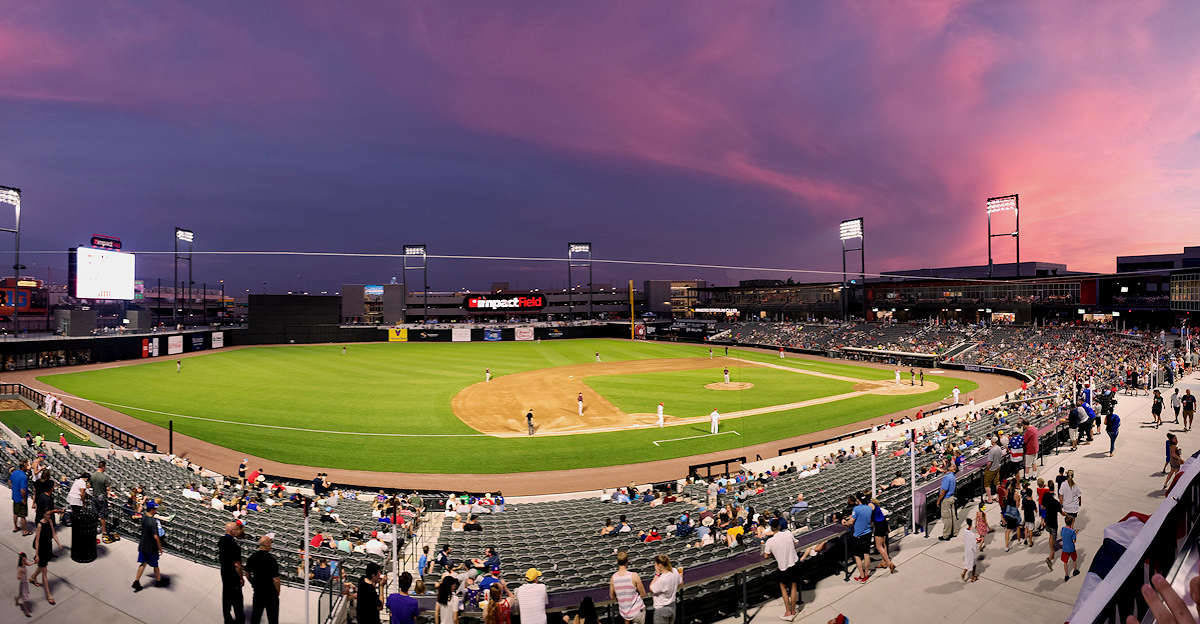Article and all photos by Joe Mock, BaseballParks.com
All rights reserved
Have you ever driven out of O’Hare International Airport in Chicago? Long before you arrive in The Loop downtown, the first community you encounter is Rosemont. The village of 4,200 residents sits on the eastern edge of the sprawling airport grounds. Rosemont might be small but it has giant aspirations, and has long prided itself on being the entertainment hub for the entire metro area.
| Ballpark Stats |
 |
| Team: Chicago Dogs of the independent American Association |
| First game: May 25, 2018, an 8-4 loss to the Kansas City T-Bones |
| Capacity: 6,300, including 5,526 fixed seats plus six party decks and seven suites |
| Dimensions: LF – 312; LCF – 350; CF – 390; RCF – 370; RF – 293. The wall is 13’6″ tall. |
| Architect: AECOM is Architect of Record and Snow Kreilich did Concept Design |
| Construction: Joint venture of Northern Builders and Degen & Rosato |
| Price: $63 million which includes the parking garage |
| Home dugout: 3B side |
| Field points: Southeast |
| Playing surface: Kentucky Bluegrass |
| Naming rights: Impact Networking, a business-automation firm headquartered in Lake Forest, IL, committed to a 12-year naming-rights deal |
| Ticket info: thechicagodogs.com/tickets or call 847-260-2544 |
| Betcha didn’t know: Patrons in the “Fan Experience” suite can take swings in the team’s indoor batting cage |
Which is why you’ll encounter billboards announcing ROSEMONT It’s all here as soon as you enter its boundaries. Like Arlington, Texas (Six Flags theme park, Hurricane Harbor water park, the Rangers, the Cowboys and a huge entertainment complex currently under construction), you’ll find a community that fancies itself the entertainment center for a huge metro area.
For decades the home of the Allstate Arena (formerly called the Rosemont Horizon), there is now iFLY indoor skydiving, an 18-screen movie theater, the Rosemont Theater concert venue, an ice rink, the 130-store Fashion Outlets of Chicago, a convention center, the home stadium of the Chicago Bandits women’s softball franchise (think Jennie Finch), 15 hotels and 50 restaurants.
And Rosemont only encompasses an area of less than two square miles!
If that weren’t enough, you can now add a $63-million baseball stadium to Rosemont’s entertainment mix. The billboard is true! It’s all here!
Impact Field, the spacious home of the first-year Chicago Dogs of the independent American Association, made its triumphant debut on May 25. The boisterous sold-out crowd bodes well for the franchise, which is seeking to carve out its own niche in the crowded Chicago sports market.
Is the stadium going to help them get there? The team’s ownership, Shawn Hunter and Steven Gluckstern, are confident enough that they agreed to a 20-year lease on the facility. That’s because they believe they have a ballpark where — like Rosemont itself — “it’s all here.”
Hunter explained to BaseballParks.com that the project got off the ground when he met with Rosemont Mayor Brad Stephens in 2015. “I’d had a background in new development and launches (of sports franchises), and he was looking to bring professional baseball to Rosemont. At the suggestion of mutual friends, we met and hit it off, and we were designing this ballpark in January of 2016.”
Unlike Stephens’ earlier overtures to the Cubs about replacing Wrigley Field with a new stadium within the Village — an effort Hunter characterizes as “more tongue-in-cheek” — this project was actually feasible. “I mean, if you look at our footprint, it would be rather difficult to put 40,000 seats in here, unless you built it really tall or over the (adjacent) highway,” he quipped. “But if there is a connection with that offer, it’s the Mayor’s passion for baseball.”
The Village provided the land and floated bonds to fund the construction of the ballpark and an attached parking garage. The total pricetag for the two structures is $63 million.
| Top Dog |
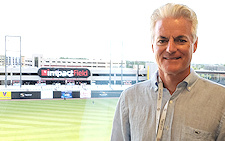 |
| Team owner Shawn Hunter has a fascinating background in sports, particularly in launching franchises. He started as an intern at the expansion Minnesota Timberwolves in 1989 (“I was one of the first ten employees hired there,” he recalled). After a stint with the Denver Nuggets, he became the Executive VP of the Colorado Avalanche when they moved to Denver, and then was the president of the Phoenix Coyotes after the Winnipeg Jets moved to Arizona. But he now admits “I always wanted to own a minor league baseball team.” |
The City of St. Paul constructed CHS Field in 2015 for the Saints of the American Association, the same league that now includes the Chicago Dogs. The success of CHS Field, in a way, contributed to the design of Impact Field. Integrated global infrastructure firm AECOM joined with Snow Kreilich Architects of Minneapolis to design the St. Paul park, and “we were recommended based on our work on CHS Field to the Mayor of Rosemont and the business partners,” explained Scott Jones, project manager at AECOM.
“Both Impact Field and CHS Field illustrate the evolution of a new contemporary aesthetic to ballpark design,” Jones added.
The site of Impact Field is fascinating for a number of reasons. It’s half a mile from the eastern edge of O’Hare (“We have to give them ample notice to get their permission whenever we do fireworks” says Hunter), while just beyond the park’s left field is one of the region’s major highways, Interstate 294. On the same side of the highway as the ballpark is Jennie Finch Way, which features the Bandits’ softball stadium and The Dome, an inflatable facility for indoor youth sports tournaments.
As you sit in Impact Field and look across the highway, you see the iFLY indoor skydiving facility, the Big 10 Conference’s striking HQ building (wouldn’t the park be the perfect home for their post-season conference tournament? “We agree!” Hunter answers enthusiastically), and just down the street, the Fashion Outlets mall.
But Impact Field’s site is noteworthy for another reason: how in the world was the Village’s desired parking garage supposed to fit on it along with the park? “That was the challenge,” Jones pointed out. “Early on, we looked at a number of schemes for the orientation. We finally got (the park) turned so it was addressing the Interstate, for the views out and for the views into the park. That really created a synergy for the site that clicked. It really worked.”
Jones laughed as he pointed out that the tight parcel of land held an interesting benefit: “The size of the site actually helped us reach the desired budget because we couldn’t add more (features)!”
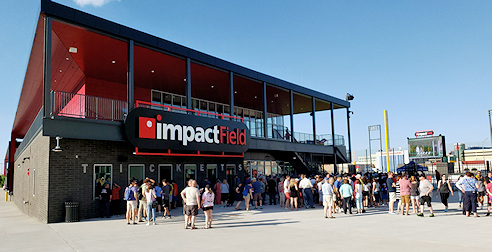 |
| The main entryway isn’t behind home plate, like at a lot of parks. It is near the right-field corner, which makes it an easy walk from the parking garage. |
With the budget met and the park and garage complete, the Village of Rosemont finally had the baseball showplace that it had been seeking. “We’re thrilled with the public’s reaction to the new ballpark,” Mayor Stephens told us. “The park is a perfect addition to our entertainment district and is further evidence that in Rosemont, truly it’s all here.”
So why do the Chicago Dogs feel that it’s also “all here” in their park? When you consider the architectural features and the concessions, it’s easy to see why.
When asked to list his favorite features of Impact Field, Hunter quickly listed five. “First is the 360-degree concourse. We did a lot of research of spring-training and minor-league parks, and when we asked the teams what they would do differently, the answer was always ‘Make the concourse wider.’ So we have very wide concourses.”
Indeed, the width of the main concourse circling the field is comparable to — and far exceeds — many big-league ballparks. Even when the game is sold out, it’s nice being able to navigate to your desired destination.
 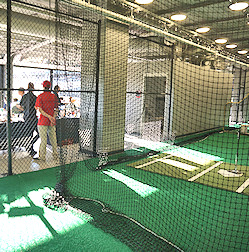 |
| The suite called The Fan Experience is, well, an experience. Not only do you get a close-up view of the action on the field, you can take a few cuts in the Dogs’ indoor batting cage. |
Second on Hunter’s list is a suite called The Fan Experience. It’s located underneath the outfield concourse, looking out at the playing field through the left-field wall. Oh, and it just happens to be adjacent to the team’s indoor batting cage — and during the game when the players aren’t using it, fans in the suite can go in and take a few swings. “In minor league baseball, that’s one of the nicer amenities that I’ve ever seen, and it would probably rival a lot of Major League Baseball (features),” Hunter notes.
Third is the private club on the upper level down the first-base line. Called the Rivers Stadium Club, “it’s a beautiful, multi-purpose space that can accommodate up to 250. We anticipate it will be booked two to three times a week year-round.
“Fourth would be the collection of separate destinations,” Hunter continues. “These six party decks each have their own special furniture. None look exactly like the others.” One of them, the Miller Lite Bullpen Terrace that overlooks the visitors’ bullpen, is Jones’ favorite spot. “That’s where I’d take a group,” he says.
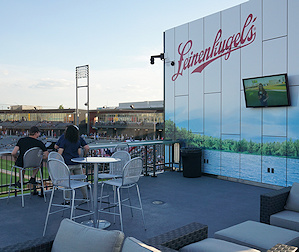  |
| One of the larger party decks is the Leinie Lodge, on the upper level behind 3B. |
Based on bookings by groups for the rest of the team’s first season, the idea of giving each of the party decks its own distinctive personality and vantage point has been quite a hit
Hunter concludes his “top five” with this: “Even our bleachers have backs, making them more comfortable. A family of four can buy tickets and eat for under $50 and do it with a little bit of comfort.”
Speaking of eating, it’s accurate to say the concession offerings are “all here.” That’s because Levy, which handles the food service at a staggering 41 pro ballparks — including at nearby Wrigley Field and Guaranteed Rate Field (in case you haven’t been paying attention, that’s the current name of the White Sox’ stadium) — handles the concessions. Fans can find pizza by the slice at the Pies stand behind first base and Mexican treats at Salsa behind home plate.
Burgers and typical ballpark fare — but with Levy’s trademark high-quality ingredients — can be found at the Flashpoint Grille stands on each side of the infield, and the Sweet stand has, of course, desserts.
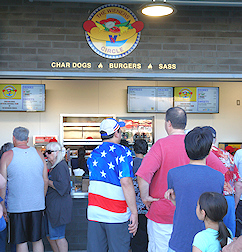 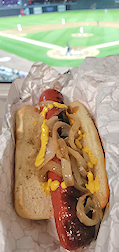 |
| Here you’ll find the world’s second Weiners Circle — where hot dogs are served with sass. You can get their Char Dog ($5) and Char Polish ($6), which is shown here. It’s OK to apply mustard. Ketchup? Nope. |
The star of the concession show, though, has to be The Weiners Circle. It’s located behind first base and is operated by the iconic hot dog stand of the same name on Clark Street (just a mile a half south of a ballpark which you might’ve heard of on Clark). It’s famous for its “char dogs” and sassy banter.
So iconic is this establishment that when the team decided that its nickname was going to be The Chicago Dogs, the public announcement was made in front of The Weiners Circle. “We thought it was very appropriate,” Hunter revealed. “And it was through our friendship with them that we said, ‘Hey, why don’t we open the world’s second Weiners Circle inside Impact Field?'”
| Hero and Anti-hero |
 |
| “Everyone expected us to put a guy in a hot-dog suit for our mascot, but we went in another direction,” explained Hunter. “Anyone in Chicago would tell you that you don’t put ketchup on a Chicago dog, so we made our two mascots the anti-hero Ketchup to go along with the hero Mustard.” |
 |
The maker of the dogs and Polish sausage served at the stand is Vienna, which is headquartered in (of course) Chicago. Because Vienna is one of the ten “founding sponsors” of the franchise, a 17-foot-tall replica of their logo — the “Vienna Beef Fork” — protrudes upward from the left-field concourse. It’s internally lit, so it shines all night as thousands of cars whiz by a few feet away on the Interstate.
The concept of having only ten founding sponsors is a manifestation of Hunter’s belief. “We’ve gone with a ‘less is more’ philosophy. (It’s) something I’ve practiced for the last 20 years. It’s a clean experience for the fans and a clean experience for the partners.” Those ten are the only ones advertised on the outfield walls … and even more importantly, their ads appear on the reverse side of the massive video board in left field. That side, of course, faces Interstate 294.
“The back side of scoreboard is perhaps our most valuable marketing asset,” Hunter revealed. “Just our ten founding partners get to advertise on it, 24-7 year-round.
“Our goal is to be big-time entertainment at affordable prices,” he continued. “The only thing we want to be ‘minor league’ is our ticket prices.” He succeeded. Tickets for the four rows of bleachers along the top of the right-field wall cost $9. These — with backs, remember — are a nice substitute for grass-covered berms that you typically see at parks below the big-league level.
The seats closest to the backstop are called the Wintrust Home Plate Club. They cost $25 and include wait service. The rest of the seats in the infield go for $16, and farther down the foul lines, tickets are $12. In a market like Chicago, these hardly seem unreasonable.
Parking in the adjacent parking garage is $3. When I informed Hunter that the Cubs charge $50 and $30 at the two public lots the club controls, he instantly replied, “We feel good at three!”
The parking garage is adjacent to the right-field concourse and is quite visible from all areas within the park. Its design works well with the various structures that make up the stadium – and it’s those structures that make Impact Field look like no other ballpark. The field-level seats are all between the concourse and the field, while the buildings on the other side of the walkway hold concessions, restrooms and, on the second level, the pressbox, suites, Rivers Stadium Club and the “Leini Lodge,” which Hunter notes was inspired by The Rooftop party decks at Coors Field.
Those structures, which Jones calls “a single continuous ribbon which folds up and down as it weaves around the ballpark,” have strategically placed gaps between them. He points out that the openings provide needed airflow while offering some spots with shade.
But it’s the structures’ color scheme of blacks and reds that really sets this ballpark apart from others. It’s both striking and quite attractive.
The structure adjacent to the main gates near the right-field corner contains the fantastic souvenir store. And, yes, you could say “it’s all here,” too.
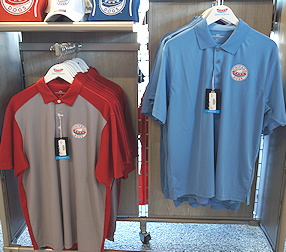 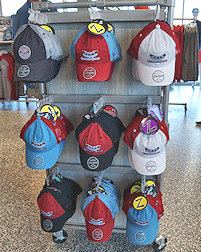 |
| The Dogs outdid themselves in coming up with apparel that shows off the clever team colors. |
I wish more of the teams — especially those over in the affiliated Minors — were as clever with their merchandise as the Dogs. They make great use of their team colors of red and light blue in t-shirts for men and women ($20-$25) and kids ($16-$20). Polos for men (ranging from $40 to $70, see photo) look especially good in these colors.
But it’s the variety of ballcaps that blew me away (adult caps are $25 and $30 and for kids $18 and $25). They even had quite an assortment of my personal favorite souvenir item: lapel pins … and they are only $5. I know I’m always quite disappointed when I go into a store (especially at an affiliated park) and they carry no pins at all. Poor merchandise-buying decision if you ask me.
Is the brightly colored and cute hot-dog-themed apparel a hit? “The early answer is yes,” replied Hunter. “We’ve done incredibly well (here) and we’re doing really well online. We have an interesting following outside of Chicago, because of the name, the logo (and) the color scheme.”
In fact, comedian Will Ferrell’s Funny Or Die tweeted this comment as the ballpark was about to open:
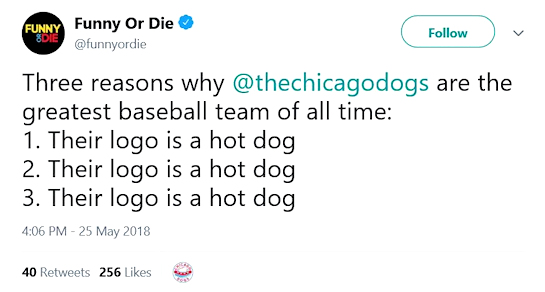 |
Why can’t baseball be fun? Shawn Hunter had definitely been involved in some serious business ventures in helping to get major-league sports franchises launched in new markets. Yet he says he’s wanted to own a team like the Dogs for a long time — and have some fun with it. “I’ve always had great respect for minor league baseball — the entertainment, the value, the focus on family and affordability.” What could be more fun — and more baseball — than a hot dog? And what could be more Chicago?
It certainly didn’t take long for baseball fans near and far to discover the playfulness and fun of the Chicago Dogs. And with a facility to match, folks in the Chicagoland area are finding that “it’s all here” at Rosemont’s new ballpark.
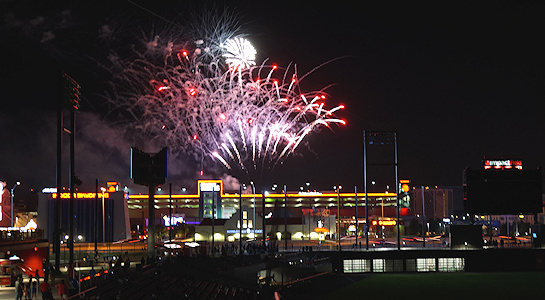 |
